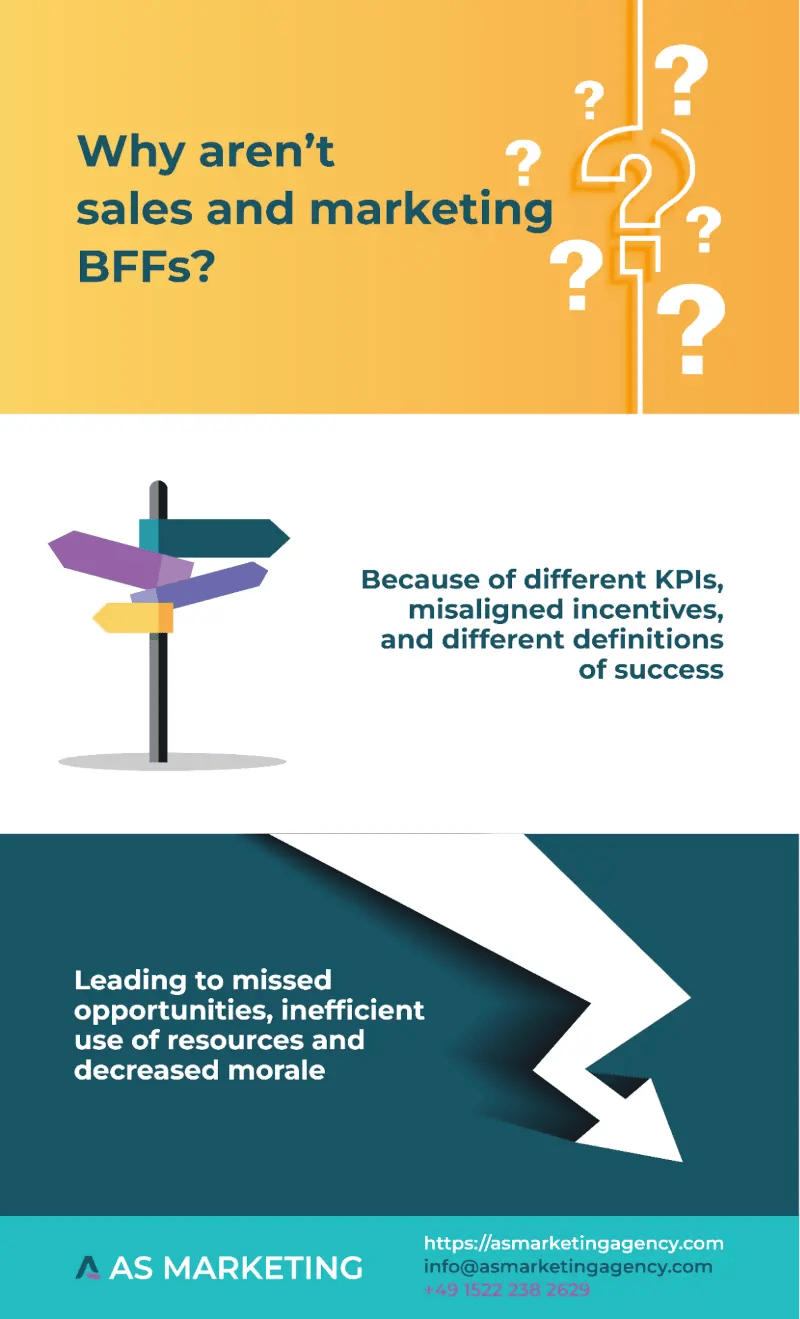Sheila from Marketing storms into the Zoom meeting in a tizzy. Steam seeps out of her ears.
“Uhm, you ok?” Linda from Sales mutters through her mic.
“No, I am not okay…what happened with all our leads lately, why don’t we have more sales!?” Sheila frantically snaps back while slugging down her green tea latte.
Linda takes a deep breath, carefully chooses her words, and out comes…
“Well, Sheila, being on the sales side of things – you have to understand buying cycles…”
Sheila from Marketing leans in closer and eagerly anticipates Linda’s next words.
“...It’s summer, and decisions are on hold. People simply aren’t buying as much, because they’re on holiday. So, while you and your team have given us an influx of leads, the reality is none of them are ready to buy.”
Sheila’s forehead wrinkles start to dissipate as a new stream of empathy has formed within her.
Now that they’ve both understood the root of the issue, they begin to brainstorm how they can improve their strategy to anticipate this gap over the next years.
This is the benefit of sales and marketing alignment.
While cat and dog fights may occur between sales and marketing teams — in the end, both should be seeking the same goal: to obtain more revenue.
So, how do you create sales and marketing alignment? And how can both teams come together to form a B2B revenue strategy?
Today I’ll do a deep dive into crafting an aligned strategy where everybody wins.
Why aren’t marketing and sales BFFs?
While it’s easy for Sheila from Marketing to feel frustrated about leads not converting, it can be equally draining for Linda from Sales to force leads through an untimely, and many times unpleasant, buying process.
Sales and marketing can and will become snippy if clear communication and empathy are lacking.

Other factors that add fuel to the flame are:
- Different KPIs: Marketing may be focused on brand awareness while sales is looking at quarterly targets.
- Misaligned incentives: Sales may be focused on commission while marketing is looking at long-term customer retention.
- Different definitions of success: Marketing may see a successful campaign as one that generates a lot of leads, while sales see it as one that closes a high percentage of those leads.
And when all these moving parts are misaligned, it can lead to more problems such as:
- Missed opportunities: If sales and marketing are not aligned, it’s possible that leads will fall through the cracks because they hear scattered messaging.
- Inefficient use of resources: If sales and marketing are not working together, they may end up duplicating efforts or working on entirely different purposes.
- Decreased morale: When sales and marketing are not aligned, it can lead to frustration and decreased morale among team members because neither party is meeting their goals.
Both teams must work together to create messaging that has the company’s growth and success in mind, not siloed, short-term metrics.
In the beginning, it may take an extra hour here or minute there to carve out a strategy that aligns, but when marketing and sales are educated on the importance of what the other does (and vice versa), it will surely save time (and prevent arguments) in the long run.
When the teams step away from attributing every single action and instead focus on their overall impact and engagement, everyone wins.
How to create marketing & sales alignment
Let’s take Linda from Sales and Sheila from Marketing through this step-by-step process of creating alignment and ending the chaos once and for all.

1. Define common KPIs & lead scoring
Linda from Sales and Sheila from Marketing are getting set up for an initial KPI alignment meeting. Here they’ll discuss revenue-oriented KPIs, so that it’s clear what the goals are and it’s easier for everyone to be on the same page. Think about it like their north star. Before the meeting, they both come up with a list of KPIs that matter to them.
Then during the meeting, both teams come up with a common definition of a “successful campaign” as well as the KPIs attributed to that. This type of approach has been proven to lead to:
- Increased annual company revenue
- Better brand awareness
- Larger average deal sizes
Pro Tip: Throw the concept of an “MQL” out the window. Instead, define together what an SQL is, and both work towards generating and qualifying those.
2. Create alignment incentives
Who doesn’t like winning? When Sheila and Linda work together for the common good of the business, it makes it even sweeter, because the company earns more money. That makes it quite the easy opt-in for leadership, because guess what their goal is? (Yes, that’s a rhetorical question)
If you’re a leader and would like to improve sales and marketing alignment in your business, create “alignment incentives.” This could be things like:
- When shared KPIs are met, both sales and marketing teams get commission
- When shared KPIs are met, both sales and marketing teams get a holiday paid for by the company
- When shared KPIs are met, both sales and marketing teams get a free smartphone upgrade
To ensure that the reward matches the effort, leaders should even ask these teams what types of rewards motivate them and try to craft something that’s feasible.
3. Be intentional with content creation
Creating content for the sake of creating content benefits absolutely no one. That’s why every resource spent in content creation should go towards using that content for a specific purpose.
And the best way to identify that purpose is to interview customers. Learn what makes them tick, learn what they like and dislike, and how their buying behavior and thought processes change over time.
Marketing, if you’re not used to sitting in on customer interviews (or vice versa), you best get used to it. Interviewing customers with both sets of ears means maybe Sheila picks up on something Linda doesn’t. Two heads are better than one. And because they’ve been at the same meeting, sales and marketing can generally take away the same information.
Once customer interviews are collected and all the data is ready to start crafting content, the process becomes much more seamless. Marketing can craft content that’s aligned with the conversations consumed and that reflects the buying journey. While sales is utilizing this material on prospects (and it’s working), the sales team will increase their trust in marketing.
Pro Tip: Case studies are the perfect piece of content to build customer trust and build sales trust in marketing. The key here is that sales and marketing should create case studies together.
4. Cross-train departments
Remember that small lightbulb moment of empathy Sheila from Marketing had in the beginning? It’s because she took a moment to understand where Linda from Sales was coming from. And instead of playing the blame game, they decided to work together to solve the problem.
When each department is provided the time to learn about what the other team does and needs to function successfully, this creates empathy - and empathy is at the heart of any successful business.
Consider creating a playbook to streamline education and shadow each other on a regular basis.
5. Function as one department
Stop working in silos and functioning as two separate departments. It may be a stretch, but do we even need “marketing” and “sales” departments anymore? What if we just called it “revenue operations”? Cue – *One Love by Bob Marley*
All jokes aside, when our mindset isn’t divided because we’re working to achieve the same goal, we can truly create a bigger impact.
By adopting a revenue operations approach and mindset, we can ensure that all moving parts align. A revenue operations strategy focuses on aligning people, processes, and technology across departments to drive efficiencies and visibility into the entire customer journey.
So if you combine this approach with sales and marketing defining common goals for success, that creates a mega win-win for the entire company.
6. Adopt social selling
Marketing and sales tactics apply in a similar manner when social selling, especially on Linkedin.
Encourage both sales and marketing to create content and be active online (but don’t write it for them). Let your people create the demand for your products and build affinity for your company. Let them become the thought leaders.
In the end, sales and marketing is all about people, even in B2B. Use this to your advantage.
Pro Tip: Host a cross-departmental Linkedin challenge. Foster healthy competition to make the two teams work as one and create rewards tied to total group performance rather than individuals.
Marketing & Sales Alignment Creates the Perfect B2B Win-Win
By creating an environment where Linda from Sales and Sheila from Marketing are as close as Monica and Rachel from Friends, you’ll quickly see more efficient use of resources, increased morale, and improved results.
While it can be easy to turn the other way and keep pushing through “business as usual,” this reality will eventually set in:
The B2B landscape is changing, so you can either come together to work toward a common goal and create true long-term success, or you can run around haphazardly while the problems persist.
What will you choose?




